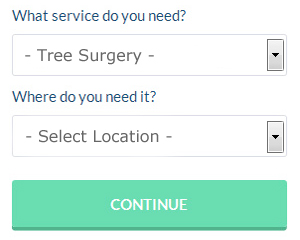Iver Tree Surgeons (SL0): Whilst there are a lot of maintenance tasks that you may do in the garden by yourself, you will find that there are certain projects that should not be done unless you know exactly what you are up to and you have got the correct tools to do them in safety. A process that falls into such a category is tree care. While you might think that it's simple to chop a couple of branches off a tree, there's actually far more skill involved than you would believe. If the process is not carried out at the right time of year and not conducted in the proper way you might injure the trees, which may in the end cost much more cash than if you'd have hired a knowledgeable tree surgeon to begin with. If you've got more mature trees involved you'd be unwise to even contemplate trying to deal with them by yourself, as, apart from everything else, you might potentially end up in A&E with bone fractures or perhaps even worse. And so, your a main concern must be to look for a decent tree care specialist in Iver.
Tree surgeons are brought in for all kinds of factors relating to trees and their care. The most common aside from addressing wind ravaged or hazardous trees are doing away with old tree stumps that are causing a nuisance, reducing or thinning trees to allow more light into the garden, developing tree management or maintenance plans to keep your trees in good condition and examining trees for disease or damage so that these issues will be resolved early on. Removing dangerous or damaged trees is undoubtedly their most apparent function, and you'll sometimes see them hard at work after stormy weather.
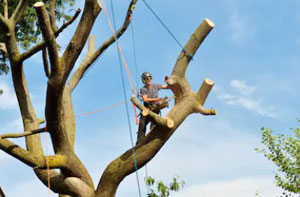
Before you hire a tree surgeon you must make sure that that they're members of the Arboricultural Association, the primary professional trade body for this occupation within the UK. They must also have the correct public liability insurance to cover for any mishaps or accidents, and they ought to be willing to help you with filling in applications to the local authority for approval to do the desired tree work. A tree inspection must be completed prior to any work beginning to be sure that the trees aren't within a Conservation Area or subject to a TPO (Tree Preservation Order).
Safety is naturally the major concern when carrying out any kind of tree surgery in Iver, and your chosen tree surgeon should be familiar with all the correct safety procedures. He'll come armed with all the essential gear to work safely on your trees to make certain that they're not in any way harmed throughout the process, nor is any injury done to yourself or your property whilst any work is being carried out.
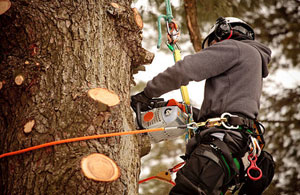
When your tree surgeon turns up he or she will unload an array of tools and equipment, much of which he'll use for either clambering up the tree, chopping branches off the tree or treating the resulting waste materials and branches. This equipment will include the likes of pole saws, flip lines, chain saws, lowering winches, rigging ropes, rigging pulleys, wood shredders, harnesses, winches, climbing ropes, loppers and stump grinders. Some of this equipment is amazingly clever and helps to make the entire process just a bit simpler and safer.
The proper disposal of waste materials should be a moral responsibility for all tree surgeons, therefore you must make certain that your prospective tradesman heeds that requirement. Tree surgeons will be able to let you see their waste carrier, dealer and broker licence, which allows them to dispose of waste materials. The safe removal of waste which is a result of work done on your property really should be included in your estimate, so double check this before work commences.
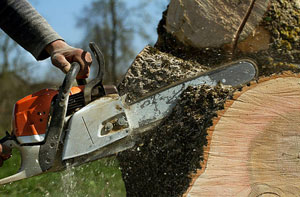
It isn't just in Iver itself where your tree surgeon will be happy to work, therefore people living in surrounding areas like Uxbridge, Slough, Wexham, George Green, Thorney, Cowley, West Drayton, Harmondsworth, Colnbrook, Yiewsley, Gerrards Cross, Stoke Poges, Langley, Iver Heath and others, are still able to get trees dealt with when necessary. Thus, wheresoever you are looking for a reliable tree surgeon, whether it's in the Iver district itself or anyplace throughout Buckinghamshire and the encircling counties, this info will be useful for you.
Tree surgeons don't just clamber up, fell and trim trees using specialist tools and equipment, they're also tasked with their conservation and protection. By means of vigilant observation they are able to spot potential hazards that may put passers by in jeopardy. A vital part of their duties is making certain trees are healthy, disease-free and in a position to prosper and grow.
Tree surgery can be provided in Iver and also in: Uxbridge, Slough, Wexham, George Green, Thorney, Cowley, West Drayton, Harmondsworth, Colnbrook, Yiewsley, Gerrards Cross, Stoke Poges, Langley, Iver Heath, and in these postcodes SL0 0RL, SL0 0LX, SL0 0DX, SL0 0NJ, SL0 0HY, SL0 0LT, SL0 0LZ, SL0 0QN, SL0 0RE, SL0 0DW. Locally based Iver tree surgeons will most likely have the postcode SL0 and the phone code 01753. Checking this should ensure you're accessing a local tree surgeon. Iver homeowners can benefit from these and lots of other tree related services.
For this kind of assistance it is definitely far better to hire a trusted local tree surgeon. Iver property owners can benefit from the skills that a trained professional can offer.
Obtaining Advice and Information
To ensure that you employ a tree surgeon who is both competent and who'll not inflict permanent damage on your trees, there are some questions that you should ask when trying to find a tree surgeon in Iver. Suitable questions should be along the lines of: Are you a member of a reputable professional body (i.e. The International Society of Arboriculture or the Arboricultural Association)? Have you got public liability and employers insurance? Are you able to provide me with references from past clients? Does your work satisfy the British Standard (BS3998)? Will you give me a written quotation? Do your employees and you have the appropriate qualifications and certificates (for using chainsaws and tree care)? You ought to think twice about employing a tree surgeon if you don't get positive replies to any or all of these basic questions.

To find a great deal of useful advice about what to look for in a good tree surgeon, along with a searchable directory of qualified tree surgeons in the UK, you should visit the Arboricultural Association site. The ISA is another fantastic resource which includes a "find a tree surgeon (arborist)" tool and a "verify tree surgeon's credentials" tool. You'll also study detailed info on tree surgery as a profession by visiting the trusty Wikipedia "Arborist" section here. Trustmark is a Government supported website that's also a good stop-off-point for obtaining genuine tradespeople.
Tree Surgery Courses - Training - Apprenticeships Iver

Having employment as a tree surgeon is an enjoyable and rewarding way to make a living. Alternatives like registering for a private course, gaining a tree surgery apprenticeship, taking a university course, beginning at the bottom (perhaps as a groundworker) and working your way up or applying for a college course are accessible to anyone in Iver hoping to be a tree surgeon. When they're on offer, tree surgery apprenticeships in Iver can be applied for whilst still at school. Private and college courses are offered throughout the UK and are open to folks of all age groups. University courses are available in various fields including countryside management, forestry, forest management, arboriculture and woodland ecology & conservation, with higher national diplomas, foundation degrees and degrees open to students with the correct qualifications (usually 1 to 3 "A" levels). If none of the options above are up your street, it might be possible to attain a bit of tree care experience by undertaking voluntary work for organisations and groups such as the Forestry Commission, the Tree Council, the National Trust or the Woodland Trust. If you got here looking for info on "how to become a tree surgeon in Iver", with any luck this brief article has proved useful. You can see more tips on ways to become a tree surgeon by visiting the National Careers Service website. (Tags: Tree Surgery Apprenticeships Iver, Tree Surgery Courses Iver, Tree Surgery Training Iver)
Health and Safety Considerations

One of the main worries with tree surgery in Iver is the health and safety aspect, since this is a risky and dangerous undertaking if conducted incorrectly. There are plenty of factors that can go wrong if the so called tradesmen carrying out the project are incapable or inexperienced. Among the most typical issues are no protection from falling, in the shape of platforms, ropes and harnesses, failure to put on cut-proof (chainsaw-proof) apparel (especially safety boots and trousers), not putting on eye or hearing protection, not roping off the work area to safeguard passers-by and vehicles, falling branches and timber and inadequate head protection. Owing to such incompetencies, potentially in danger are workers at ground level, vehicles, passing pedestrians, garden sheds and fences, the people living in the property, the tree surgeon himself (up the tree), the home or property, the actual tree itself, the street facilities.
Protecting Trees in the Wintertime
Whilst the winter climate is rarely severe enough to warrant protecting your shrubs and trees, it is definitely worth looking at as a precaution. Even the trees, plants and shrubs that we usually consider to be hardy, can find winter a tough time to endure, particularly during the colder months, and they will invariably benefit from a bit of TLC and extra protection.
When you have trees in your garden in Iver, it's high winds and storms that cause the biggest concerns, and they might still be susceptible even though most of them will have already dropped their leaves come winter, thus being less resistant to wind. If you are concerned about a tree's condition, or it seems like it might topple over, you should call in a tree surgeon to check it out and do a risk assessment. Trees can also suffer damage because of heavy snowfall, so stay alert for damage in this type of weather. Protection from ice and frost might be required for some shrubs and trees (in particular ones that have been recently planted), and a deep layer of mulch around their bases can help keep their roots from freezing, and allow them to absorb moisture.
Dead-Wooding Iver
Dead-wooding (or deadwooding) is an essential part of tree management, and all experienced Iver tree surgeons will carry out this procedure where needed. Calling for the removal or dying and dead branches which could pose a danger to buildings, passers-by or vehicles, dead-wooding helps to make a tree both healthier and safer. The most commonplace reasons for the branches of a tree dying off are attack by pests, disease, light deficiency or root damage, and this is of course a totally natural process.
Whilst the usual reason for the removal of dead branches is that of safety, it's also sometimes done for the benefit of the tree, or for aesthetic reasons. An excessive number of dying, damaged and dead branches can encourage infestation by insects and disease, so the removal of these offending branches can dramatically improve a tree's health. Dead and decaying wood can also make a tree look unattractive, and by removing all of this, you can make it look more appealing.
Generally only the largest dead branches will be taken out, because small ones present minimal risk. Nonetheless, where a road, a public area, a home, a park or a garden in Iver is overhung by trees, any dead limbs of over fifty millimetres diameter may have to be removed.
Tree Cable Bracing Iver
A procedure that's used to offer support to a tree when it is showing signs of decay or damage or is a risk to nearby property or persons, cable bracing can be really helpful in the right situation. This method is often used on older or valued trees in Iver, where felling or the removal of large unstable sections is undesirable for reasons of aesthetics.
A cable bracing system can be used to support V-shaped forks, weak limbs and poor joints. By the installation of rods and cables most tree surgeons in Iver will be able to mitigate structural stresses and prolong the lifespan of old and valuable trees using different types of bracing work.
Cable bracing does not cause damage to the tree (as could happen when drilling and bolting the branches), and delivers a flexible and shock-absorbing means of support that is pretty much non-invasive. A thorough risk risk assessment must be conducted by a tree surgeon or arborist before any cable bracing work can be undertaken. This is necessary to ensure the safety of the tree and encircling areas as the work progresses. (Tags: Cable Bracing Iver, Cable Bracing Trees Iver, Tree Cable Bracing Iver, Cable Bracing Methods Iver).
Dutch Elm Disease
Destroying tree stocks and killing off tens of millons of elm trees all over Britain over the past 50 years or so, Dutch Elm Disease (Ophiostoma novo-ulmi) isn't so common now, as it previously was. Spread by the elm bark beetle and caused by the Ophiostoma novo-ulmi fungus, Dutch Elm Disease was accidentally imported into the United Kingdom from North America (Canada) in the late 1960's.
After arriving in Britain, it was spread quickly through the nationwide transportation of elm products such as saplings, bark mulch, crates, and firewood logs with the bark still attached. This awful disease did not just affect elms in Britain, but also decimated tree stocks in mainland Europe and North America. Whilst the origins of DED are as yet unproven, the suspicion is that it first originated in Asia.
Dutch Elm Disease usually first shows up in early summer, and the main symptoms are:
- Dark streaks beneath the bark of twigs.
- Clusters of leaves turning yellow and wilting.
- A "shepherd's crook" effect on affected twigs.
- Shoots that die back from the tip.
Due to disease and the chopping down of infected, dying and dead trees, there are now very few large elms remaining in the British countryside, therefore the spread has slowed and the beetle's habitat largely decimated. A project for the propagation of young saplings that have so far proved resistant to Dutch Elm Disease is currently being undertaken.
If you happen to have elm trees in your garden in Iver, and have suspicions they may be affected by Dutch Elm Disease, contact your neighbourhood tree surgeon for advice, or request a diagnosis from the THDAS (Tree Health Diagnostic and Advisory Service).
(Tags: Signs of Dutch Elm Disease, Dutch Elm Disease Iver, Spotting Dutch Elm Disease).Tree Stump Removal Iver
If you're in a position where you've got to have a sizeable tree cut down and removed from your property in Iver, you're perhaps going to be left with a stump, which also needs to be dealt with. In some cases it may be plausible for you to leave the tree stump in position until such time as it decays and rots away on it's own. However, stumps in your garden can attract undesirable pests, be a trip hazard, and can even send out new suckers in an attempt to regrow.
There are several techniques for getting rid of a tree stump completely, but stump grinding or stump removal are the 2 main alternatives. In the following paragraphs we will be focusing on the stump removal alternative rather than grinding.
There are in essence 3 main procedures that you can use to remove a tree stump - you can dig it out by hand, you can burn it or you can use a chemical stump killer. If you have plans to deal with a tree stump yourself, you can use any one of these methods. Professional tree surgeons will usually plump for the aforementioned stump grinding method, though might offer the alternative of a chemical removal treatment such as eco-plugging.
Stump Burning Methods: Since it might conflict with local legislation and can definitely be quite dangerous, burning a stump isn't normally recommended. Should you choose this method, extreme care must be taken. The burning technique comprises drilling several holes into the tree stump, filling keeping them topped up with vegetable oil over a period of several days until soaked. Charcoal is then heaped around the stump and lit. This shouldn't ever be left to its own devices, but be supervised constantly. Make certain that the fire is extinguished when it is completely burned out. You will be able to dig out the roots and burnt stump remains after it has completely cooled down.
A different option is digging out all the soil from below the tree stump and lighting a fire in the cavity created underneath. If your tree stump is close to fences, other trees or a building, you should not use any of these stump burning methods.
Chemical Stump Removal: Chemical treatment involves the use of a strong chemical mixture for instance Resolva Xtra Tough Tree Stump Killer, Roundup Tree Stump Remover or Vitax SBK Stump Killer. It's crucial that you follow the instructions closely when using any of these chemical solutions, because they can be very dangerous and toxic. According to the size of the tree stump, and if it is alive or dead when it is treated, it can take quite a few weeks or maybe even months for a stump to rot down entirely, so regard this as a long term resolution. Once rotted, an axe can be used to chop it up and a shovel for removal.
Digging Out a Stump by Hand: Digging up a tree stump by hand is a relatively straightforward process, and involves shoveling out out all the soil around the base of the stump, exposing and sawing all the principal roots, and finally freeing the stump so it can be lifted out. For the final freeing up process you might find that you need to get hold of a cable ratchet winch. This is tedious and tiring work.
Crown Thinning Iver
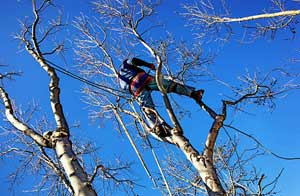
The removal of smaller live branches on the outer areas of the tree's crown, but not adjusting the overall size or shape of the tree, is known as crown thinning. This practice is meant to develop a consistent leaf density, which itself accomplishes a number of goals such as: to prevent the tree uprooting when it is windy, to let more sunlight inside, to reduce the total weight of the crown, to minimize the stress put on certain limbs caused by ice, snow, gravity, or wind or to decrease the wind resistance of the tree. The all round size and structure of the tree ought not to be altered by crown thinning, and should merely bring about a uniform foliage density encompassing uniformly spread out branches. You should be able to obtain crown thinning in Uxbridge, Slough, Wexham, George Green, Thorney, Cowley, West Drayton, Harmondsworth, Colnbrook, Yiewsley, Gerrards Cross, Stoke Poges, Langley, Iver Heath, and the Iver area.
The Use of Chainsaws
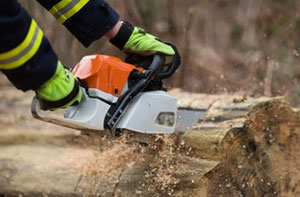
In terms of the equipment that is used by Iver tree surgeons, the most commonly seen is the chainsaw. Petrol driven chainsaws are the most popular with professionals, because of their ease of use and greater portability, although mains models can be purchased, as can battery operated chainsaws which have become popular for some processes. For effortlessly slicing through large limbs and tree trunks, petrol driven chainsaws are the only real option effective option, being extremely powerful and able to cope with even the most demanding of tree work.
Essentially, a chainsaw consists of a motor-driven chain that has a series of teeth for cutting through bark and inner wood. Besides what drives them, there are also a variety of types of chainsaw for different procedures, top-handled for working at height (and which can be used single handedly), pole saws for long distance pruning and hard to reach branches and rear-handled for work at ground level (two handed).
You will almost never find an experienced Iver tree surgeon who doesn't use a chainsaw, although being high up in a tree with a rapidly twirling blade in your hand is not the safest activity. All professional tree surgeons must be trained in the safe use and maintenance of chainsaws, and this is one of the key requirements for membership of the Arboricultural Association (AA).
The most popular brands of chainsaw used in the United Kingdom by tree care professionals are Stihl, Hyundai, Makita and Husqvarna, although there are a lot of different makes and models.
Accidents Through Tree Surgery
The work carried out by tree surgeons and tree care professionals in Iver can be really dangerous. All possible safety measures must be taken when working on trees, because tree work involves a significant risk of injuries to both operatives and passers-by.
The majority of fatal and serious injuries are linked to the use of chainsaws, falls from trees, and being struck by a falling branch or tree, as reported by the Health & Safety Executive (HSE). Surprisingly, people working in tree care have a higher chance of being seriously injured than those in building and construction.
When it comes to insurance claims the most common tree care accidents involve being struck by objects (trees, cranes, ropes, grapple hooks, branches etc), slipping from ladders and lifting injuries.
All of this emphasises the need for employing an experienced Iver tree surgeon when work needs doing on your trees. In the tree care industry, many accidents can be attributed to inexperienced workers attempting tasks that they are not trained to do, or equipped for. Therefore, to avoid this kind of issue, always try to use an experienced and reputable Iver company that has been operating in the area for a number of years.
Invasive Tree Roots Iver
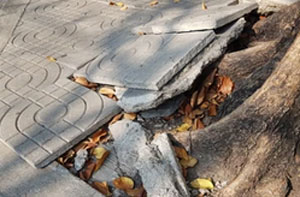
Some large trees have particularly intrusive roots, and could cause problems when they're growing too close to your property in Iver. Cracked patios, blocked drains and damaged foundations, are some of the most widespread problems that you may come across. Willows, elms, sycamores and maples, are known to have extremely intrusive root systems.
If you are planting new trees, make certain that they are placed sufficiently far from paths, patios, your drainage pipes and your home, so that they will not cause serious problems down the road. If existing trees are growing too close to your dwelling and are already causing some of these problems, you must bring in a tree surgeon in Iver, to see what can be done.
If you want to avoid killing the tree or severely affecting it's health you really shouldn't try and do this yourself and just cut out any offending tree roots. So that any damage to property is reduced, and the tree is still able to get sufficient food and water to survive and thrive, an established tree care specialist in Iver will know which roots should be left in place, and which roots can be safely cut back.
Shrub and tree roots quite often cause cracks in subterranean drains, since sewerage lines provide a constant source of nutrients and water. Minute tree roots can soon invade a drainage system's joints, and when established develop into substantial root balls which can trigger joint failure and an eventual blockage. High quality root removal services will be offered by some Iver tree surgeons, who will use either high pressure water jetting, manual rod clearance or electro-mechanical equipment to eradicate the troublesome roots. Root removal services are also available in Uxbridge, Slough, Wexham, George Green, Thorney, Cowley, West Drayton, Harmondsworth, Colnbrook, Yiewsley, Gerrards Cross, Stoke Poges, Langley, Iver Heath, and in Iver itself. (Tags: Tree Root Problems Iver, Problematic Tree Roots Iver, Invasive Tree Roots Iver, Drain Root Removal Iver).
The International Society of Arboriculture (ISA)
With its headquarters in Georgia, United States, the International Society of Arboriculture, usually referred to as the ISA is an international, non-profit organisation that encourages the awareness and benefits of trees. A membership association serving the tree care industry all around the globe, the ISA champions the professional practice of arboriculture.
Promoting best tree care practices, and focusing on research, technology and education, the ISA provides educational services, publications and events develop the knowledge, skills and arboricultural expertise of individuals working in the tree care industry.
Since an agreement between the two was signed in mid-2016 the Arboricultural Association (AA) has been an associate organisation of the International Society of Arboriculture. This enabled the 2 to strengthen their relationship, whilst providing further opportunities for any tree care professional in the United Kingdom and Ireland who was a member of the ISA. UK Arboricultural Association members can now benefit from being part of a wide and varied worldwide network of tree care professionals. The ISA now has professional affiliates and associate organisations in EXTRAvegetation management in Iver, crown lifting, tree management in Iver, crown cleaning, tree pruning, dead-wooding, damaged tree cutting and removal Iver, hazard assessments in Iver, emergency tree surgery Iver, tree maintenance, landscape clearance, tree watering Iver, tree surveys, landscaping in Iver, woodland management in Iver, stump grinding, pest control, tree topping, hedge reduction Iver, crown removal, fruit tree pruning Iver, tree fertilising, terravention, stump removal, hedge cutting, tree lopping Iver, coppicing, tree transplanting, tree planting Iver, root decompaction in Iver, health inspections, eco plug treatments, retrenchment pruning in Iver, tree felling Iver, woodchipping IverTEN, and the UK, and has a worldwide membership of more than 22000.
Storm Damage Prevention Iver
While we're all aware of the power of Mother Nature, big trees seem strong, sturdy and capable of withstanding pretty much any eventuality. The lifespan of most tree species far eclipses that of animals or humans, and in actual fact some varieties such as yews, oaks and sweet chestnuts can live for hundreds (even thousands) of years.
Despite all of this, trees are certainly vulnerable to unfavourable weather conditions, and in addition to the threat of falling limbs and branches, when faced with a certain set of conditions trees can even fall over completely, causing a lot of damage. High winds and gales pose serious problems for trees, and this sort of damage is becoming more and more commonplace in Iver, as the number of severe storms and weather events increases with climate change. Other problems can be heavy snow during wintertime, and waterlogged soil during prolonged periods of rainfall or floods.
It's recommended that you get a competent Iver tree surgeon to examine your trees to reduce the chance of problems with your trees in severe weather conditions, they'll prune and remove any dead, dying or excessively long branches that might be a problem.
To prevent taller trees getting struck by lightning, and to safeguard nearby property and buildings which may be affected by side-flashes ("jumps"), it is also a good idea to install lightning rods, copper conductors, or other protection systems. Trees can be damaged, drastically weakened, or even killed by a lightning strike, they can be burned to the ground, split in two, or left susceptible to pests, decay or disease - not a happy situation! Lightning occurs more frequently than you may think, and there are about 300,000 strikes each year in the UK alone.
Ask your local Iver tree care specialist what they can do to protect your trees from storm damage and reduce the risk of drastic consequences should an unsound tree crash down as a result of extreme weather.
Coming Soon: Tree pruning Iver.
Current Tree Surgery Projects
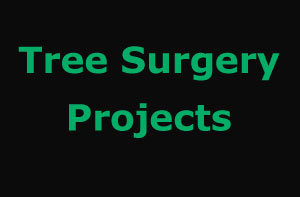
Gracie Sanders was searching for someone who can do tree surgery in Ivinghoe, Buckinghamshire. Louie White in Stewkley, Buckinghamshire asked "is there a professional tree surgeon near me?". Mr and Mrs Budd are hunting for a specialist who will chop back a 30 metre run of box hedge to a sensible height in their garden in Fenny Stratford. Mr Mitchell Pritchard in Beaconsfield, Buckinghamshire wants someone who can undertake the pollarding of several trees along a path. Mr Victor Mcdonagh in Buckingham, Buckinghamshire needs someone who's prepared to cut a tall holly hedge down to a 6ft height and clear up afterwards. In Chartridge Miss Alicia Macarthur needs a tree surgeon who can remove about eight conifers with diameters of 150mm to 200mm. Trystan Corcoran was trying to track down a tree surgeon to chop back 4 conifers and remove all the waste in his garden in Hedgerley. Miss Siena Ricketts from Great Brickhill needs somebody who's prepared to carry out a bit of after winter hedge and tree pruning.
Tree Surgery Tasks Iver

Iver tree surgeons can normally help with vegetation management in Iver, crown lifting, tree management in Iver, crown cleaning, tree pruning, dead-wooding, damaged tree cutting and removal Iver, hazard assessments in Iver, emergency tree surgery Iver, tree maintenance, landscape clearance, tree watering Iver, tree surveys, landscaping in Iver, woodland management in Iver, stump grinding, pest control, tree topping, hedge reduction Iver, crown removal, fruit tree pruning Iver, tree fertilising, terravention, stump removal, hedge cutting, tree lopping Iver, coppicing, tree transplanting, tree planting Iver, root decompaction in Iver, health inspections, eco plug treatments, retrenchment pruning in Iver, tree felling Iver, woodchipping Iver and other tree surgeon services in Iver, Buckinghamshire. Listed are just some of the tasks that are carried out by a local tree surgeon. Iver companies will tell you about their entire range of services.
How to Find a Tree Surgeon
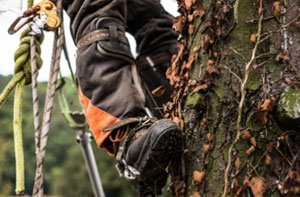
Of the wide variety of approaches available to search for nearby tradesmen in Iver such as tree surgeons, one which has been with us for several years is online directories. They're the modern day alternative of the old Yellow Pages, that everyone in the UK used to use to call local services. Today customers look in Yelp, Local Life, Cyclex, Yell, City Visitor, Thomson Local, 118 118, Touch Local and Mister What, even so entries in these are available to anybody ready to fork out the fee for listing, which is no guarantee of craftsmanship A further favoured method for finding trades-people nowadays is to search through internet portals such as Local Heroes, TrustaTrader, My Hammer, My Builder, Checkatrade or Rated People, and it is on these portals that clients are able to submit testimonials and reviews with regards to the quality of work carried out and the people who were responsible. The last and possibly even the most effective strategy is to ask family, friends and next door neighbours if they are able to suggest somebody they have used.
Buckinghamshire Tree Surgeons
Around Buckinghamshire you can likewise find: Lane End tree care services, Great Missenden tree care, Hanslope tree management, Stoke Hammond tree management, Stowe tree surgeon, Shenley Brook End tree surgery, Great Missenden tree care services, Little Kingshill tree surgery, Marlow Bottom tree surgeons, Great Linford tree surgeons, Long Crendon tree surgeon, Longwick tree surgeon, Tingewick tree management, Stokenchurch tree care services, Long Crendon tree surgery, Chalfont St Giles tree surgeons, Quainton tree management, Hughenden tree surgeons, Long Crendon tree care, Winslow tree care services, Ellesborough tree surgeon, Bierton tree surgeons, Little Kingshill tree surgeon, Bledlow tree surgeons, Haddenham tree care, Princes Risborough tree surgeon, Haddenham tree surgeons, Great Horwood tree surgeon, Edgcott tree surgeons. In every area of Buckinghamshire you'll be able to track down tree surgeons who'll provide quality services for your tree care requirements. If you can't find the ideal tree surgeon in Iver itself you shouldn't have any issues finding one someplace nearby.
Tree Surgeons Near Iver: Also find: Colnbrook tree surgeons, Slough tree surgeons, West Drayton tree surgeons, Harmondsworth tree surgeons, Iver Heath tree surgeons, George Green tree surgeons, Gerrards Cross tree surgeons, Cowley tree surgeons, Yiewsley tree surgeons, Uxbridge tree surgeons, Stoke Poges tree surgeons, Wexham tree surgeons, Langley tree surgeons, Thorney here. All of these villages and towns are catered for by a tree surgeon. Iver home and property owners can get tree surgery price quotes by clicking here.
Tree Care Services Iver
- Iver Cable Bracing
- Iver Tree Inspections
- Iver Crown Reduction
- Iver Tree Shaping
- Iver Dead Wooding
- Iver Tree Pollarding
- Iver Shrub Maintenance
- Iver Tree Bracing
- Iver Woodland Clearances
- Iver Tree Surveys
- Iver Root Removal
- Iver Crown Raising
- Iver Tree Planning
- Iver Root Grinding
Tree Surgeons Around Iver: Tree surgery quotations were recently requested by people in the following Iver streets: Glaisyer Way, Pinewood Green, Linden Close, Blythe Close, St Leonards Walk, Langley Park Road, Ward Close, Longstone Road, Hawthorn Close, Richings Place, Wood Lane, Iver Lodge, Thorney Lane South, Old Slade Lane, Pinewood Close, Bangors Road South, Bathurst Close, Chequers Orchard, Coopers Row, Evreham Road, Dutton Way, Hollybush Lane, Rostrevor Gardens, Alder Road, The Ridings, and in these postcodes: SL0 0RL, SL0 0LX, SL0 0DX, SL0 0NJ, SL0 0HY, SL0 0LT, SL0 0LZ, SL0 0QN, SL0 0RE, SL0 0DW. Work was carried out in these places by a local tree surgeon. Iver householders enjoyed the benefits of dependable and professional tree surgery services in every case.
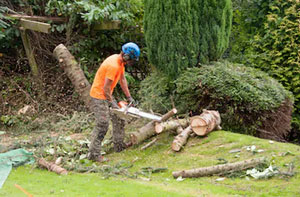 Tree Surgeon Iver
Tree Surgeon Iver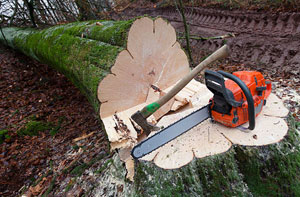 Tree Care Iver
Tree Care Iver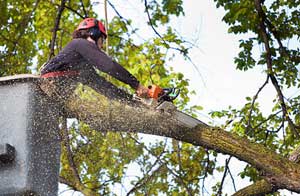 Tree Surgery Iver
Tree Surgery IverMore Buckinghamshire Tree Surgeons: Buckinghamshire tree surgeons: Chesham, Bletchley, Burnham, Iver, Milton Keynes, Winslow, Marlow, Olney, High Wycombe, Princes Risborough, Great Missenden, Buckingham, Hughenden Valley, Denham, Newport Pagnell, Gerrards Cross, Stony Stratford, Farnham Royal, Beaconsfield, Chalfont St Giles, Chalfont St Peter, Amersham, Stokenchurch, Haddenham, Aylesbury, Hazlemere and Wendover.
For the latest local info about Iver, Buckinghamshire go here
Tree Surgery SL0 area, (dialling code 01753).
More Trades: Gate Fitters - Gutter Cleaning - Tilers - Carpet Fitters - Carpenters
Arboriculture Iver - Forest Management Iver - Tree Felling Iver - Tree Surgeon Iver - Tree Care Iver - Tree Management Iver - Tree Surgeons Iver - Tree Surgery Iver - Tree Surgeon Near Me




